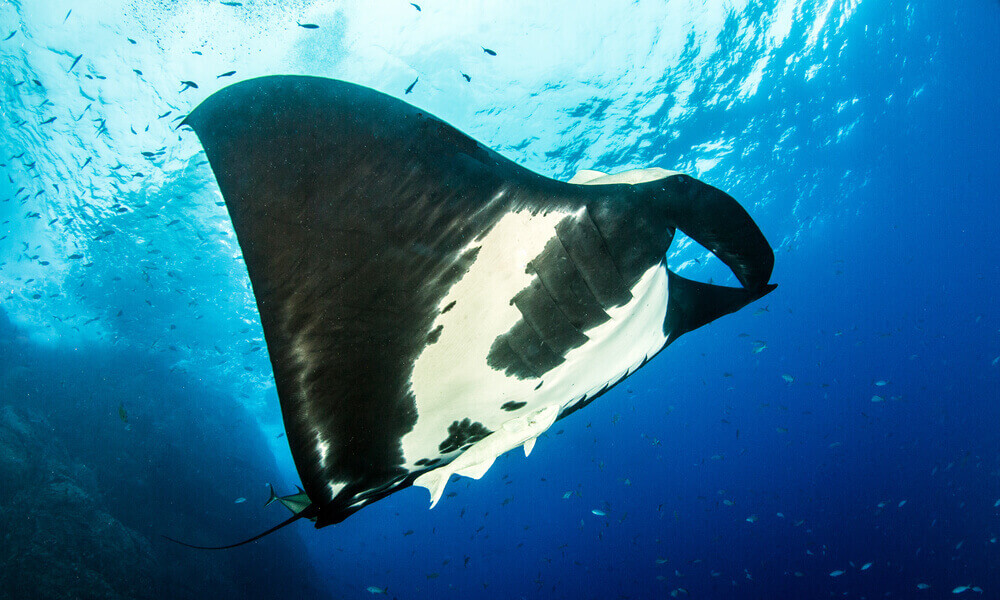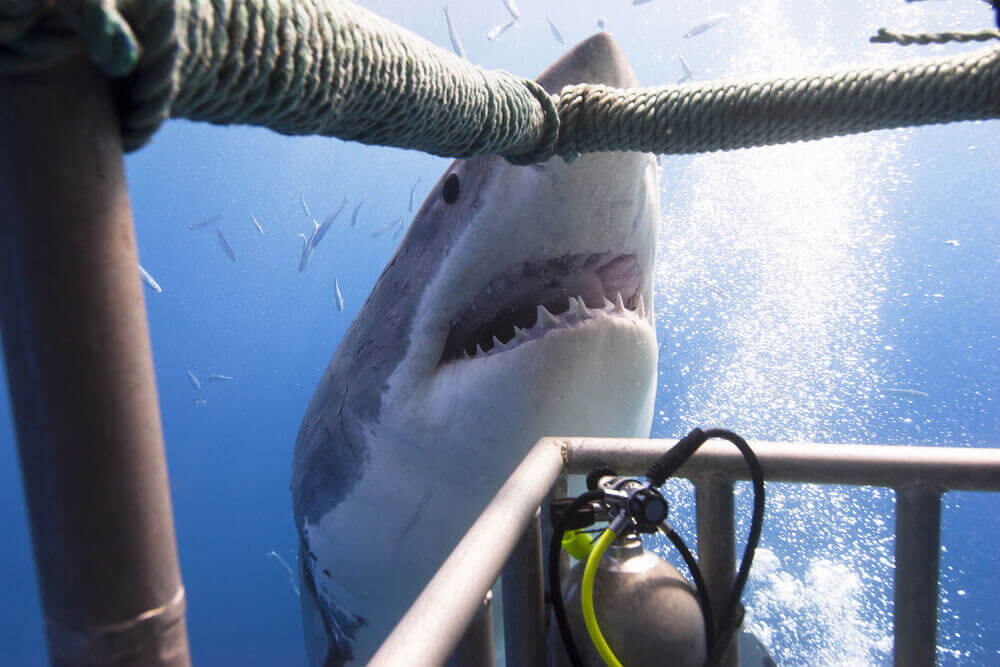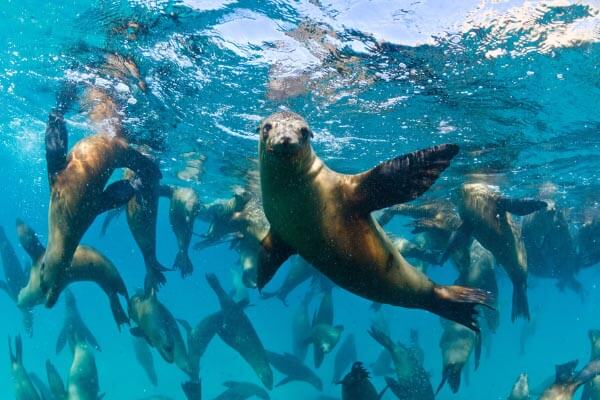
This is the place for high-energy, adrenaline diving. Exciting, demanding and, for the experienced diver, very rewarding. There are few other destinations in the world you can encounter such an impressive array of big beasts – humpback whales, giant manta rays, hammerhead sharks and, at Guadalupe Island, close encounters with great white sharks in superb visibility.
REVILLAGIGEDO ARCHIPELAGO

The Revillagigedos Islands are located south-west of Cabo San Lucas, at the tip of Baja California. They offer divers reliable encounters with giant manta rays, whale sharks, dolphins, humpback whales, tuna, pelagic fish and many other shark species.
The ‘closest’ island to the mainland is San Benedicto, 390km offshore, which has become famous among divers around the world for the dive known as El Boiler – a pinnacle covered in corals and patrolled by manta rays and sharks.
Nearly 50km to the south of San Benedicto lies Socorro Island. Socorro also has manta ray cleaning stations as well as several pinnacles where schools of hammerhead sharks are often seen. Bottlenose dolphins visit sites, such as Cabo Pearce, almost daily and long encounters are a frequent occurrence.
A further 315km to the west of Socorro is the infrequently visited Clarion Island. Not much is known about Clarion other than it is still relatively unexplored.



And 120km to the west of Socorro lies a lonely pinnacle, Roca Partida. It is situated upon a broad, flat-topped seamount, or guyot, in 80m of water, 30m height jutting from the sea and 100m wide.
Roca Partida is a magnet for sea life in the area. Pacific creolefish (Paranthias colunus) form thick clouds in the upper water column which disappear with an audible whoosh at the arrival of yellowfin tuna.
From February to April, humpback whales migrate from their high-latitude feeding grounds to utilise the Revillagigedo Islands as a breeding ground and for delivering and nursing their offspring. In recent years, there have been many documented encounters between divers and humpback whales at Roca Partida in particular, where whales have shown an extraordinary tolerance towards scuba divers.
The islands are Biosphere Reserve and a Marine Protected Area with a complete ban on fishing within 12km of each island. Conservationists are pushing for the islands to be UNESCO World Heritage listed.
DIVE SITES
EL Boiler – San Benedicto Island

El Boiler is a small guyot, roughly oval-shaped, more or less the size and shape of a football field, that rises from the bottom 35m below and reaches to just below the surface on the north-west coast of San Benedicto in the Revillagigedos. It is covered in patches of coral and is home to lobsters, octopus, and reef fish. The sides of the pinnacle are patrolled by jacks and silky sharks. And mantas. Lots of mantas.
It is not uncommon to have eight manta rays cruising the currents around El Boiler and visiting cleaning stations where clarion angelfish (Holacanthus clarionensis) flock to them and begin a service of pecking parasites from the surfaces of their bodies.
For reasons unknown, the manta rays at San Benedicto appear to enjoy playing with scuba divers, swimming past at a slow speed and stalling above the divers’ exhaled bubbles. It is believed they enjoy the sensation in the same way as humans respond to tickling. There is a strict no-touching and especially a no-manta-ray-riding policy enforced by all boats which allows the manta rays to control their level of interaction with the divers, rather than being harassed by the over-eager.
El Canyon – San Benedicto Island

The Canyon at the south end of the island has two cleaning stations that are particularly popular with large pelagics. Some days the giant mantas circle around waiting for their turn for the attentions of the king and clarion angelfish eager to devour any parasites. Keep your eye out for schools of scalloped hammerheads out in the blue. Expect to see Galápagos and silky sharks patrolling the reef.
Cabo Pearce – Socorro Island

Cabo Pearce is located on the east side of Socorro Island. Your dive boat can find shelter in a calm cove that is surrounded by rocky red cliffs and you can head off in the dive RIBs to explore this exciting outcrop. Look around immediately you roll in – you might be surrounded by bottlenose dolphins. And if you are even luckier, they might be in the mood for company. Nothing is better than spending your whole dive with 20 to 30 friendly dolphins. But don’t despair if the cetaceans are scarce –this is a great site for sharks, particularly whale sharks and there are plenty of giant manta rays.
Punta Tosca – Socorro Island

Punta Tosca is located on the west side of island – a top site for spotting humpback whales and expect plenty of shark action. Galápagos and silkies are commonly in residence and this is one of the best sites in the whole archipelago to see tiger sharks. Hiding in the fissures of the rocky reef are lots of lobsters. Divers have also reported a number of encounters with extremely playful and curious bottlenose dolphins.
The Aquarium – Socorro Island

On the east of the island is a site popular with macro photographers – given its name it is no suprise that there are plenty of fish. The garish orange Clarion angelfish form large schools – the juveniles have bright blue flashes which fade as they mature. Lots of red-tailed triggerfish and crosshatch triggerfish roam this site.
Roca Partida

Whitetip reef sharks lazily cruise on the currents next to the rock and can also be spotted crowding on the few ledges that are large enough to support them defying the surge. Manta rays frequently pass by, as do bottlenose dolphins, whale sharks and Galápagos sharks.

MARINE LIFE






GUADALUPE ISLAND
Guadalupe Island or Isla Guadalupe is a volcanic island located 240km (150 miles) off the west coast of Mexico’s Baja California Peninsula and some 400km (250 miles) south-west of the city of Ensenada, in the Pacific Ocean.
The island’s 40km (25 miles) of rugged coast is made up of steep cliffs dramatically rising out of the sea with dense forest and scrub at the top. There is a small community of abalone fishermen based on the west coast and an even smaller meteorological base on the south coast – the 2010 census had the population at 213 people.
Great white sharks
It is one of the best places in the world to see great white sharks – its relative isolation limits the boats to liveaboards (it is an 18-hour crossing from Ensenada) and the clear, blue water can result in visibility of nearly 50m (150ft).
The great whites are the only show in town – this is not a diving destination, you only come to cage dive with this mighty predator. During one season a staggering 178 individuals were seen in the water at the same time. However, there are no guarantees with wild animals.
The sharks tend to start arriving around July and are gone by the end of November. Rowdy gangs of males arrive in July and August. The larger females start showing up in October and November.
Most trips are for five days with three full days in the water with the sharks. In the peak months, it is possible that you will encounter as many as ten sharks on each dive. More than 200 individual animals have been identified in the area – if you strike really lucky and encounter a great white that has yet to be identified you get naming rights!





Certified divers will able to get up to three dives a day in the submerged cages (20m) and can use the surface cage from dawn to dusk, as can non-divers.
The sharks are here to feed – this was one of the last refuges for the northern elephant seal (Mirounga angustirostris) and the Guadalupe fur seal (Arctocephalus townsendi) when both species were nearly hunted to extinction in the 19th century for oil, blubber and their fur. In fact, scientists thought the northern elephant seal was extinct until eight individuals were discovered on Guadalupe Island in 1892 by a Smithsonian expedition, which proceeded to kill most of them for the museum’s collections. The elephant seals managed to survive, and were finally protected by the Mexican government in 1922. Today, all surviving northern elephant seals share the same male ancestor.
More than 10,000 Guadalupe fur seals now call the island home – it is the only place where they breed. And one of the few breeding colonies of northern elephant seals also mates and broods their young on the island each summer and autumn. The island has been a pinniped sanctuary since 1975.
MARINE LIFE


LIVEABOARDS
The only way to explore either Guadalupe Island or the Revillagigedo Archipelago is by liveaboard. The same boats tend to run trips to both destinations. Guadalupe itineraries are mostly for five days and leave from the port of Ensenada.
Trips to the Revillagigedo Archipelago leave from either Cabo San Lucas and San Jose del Cabo in the south of Baja Califonia. Most itineraries are for ten days. The closest international airport to either of the cities is Los Cabos International Airport, which has flights arriving from the United States, Canada and other Mexican cities.

Expect to see manta rays, bottlenose dolphins and a variety of sharks including schooling scalloped hammerheads, solitary giant hammerheads, Galápagos, whitetip reef, silver-tip, silky, tiger and oceanic whitetips all year round.
The season for whale sharks is April to December. Humpback whales congregate from January to April and the best time to see bait balls is May or June.
All the conditions that make this area so attractive to the megafauna such as strong currents, upwellings and the sheer isolation can prove a challenge for divers. Therefore this is not a destination for the inexperienced or the faint hearted. Liveaboards will require at least 50 logged dives.
Expect powerful currents, plenty of surge and there is always a chance of sudden down currents.







